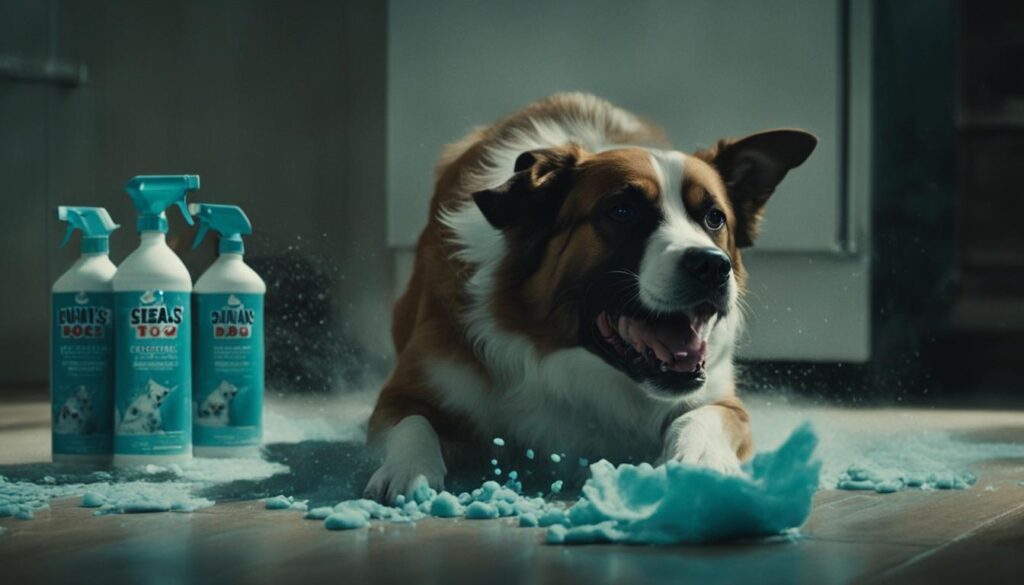Dogs have an incredible sense of smell, with between 150 and 300 million olfactory cells compared to our five million. They can detect smells in the air and on surfaces and can even identify the source of those smells. While dogs generally enjoy exploring new scents, there are certain smells they find unpleasant or repulsive. These smells can be used as dog repellents or deterrents to keep them away from specific areas.
Key Takeaways:
- What Smells Do Dogs Hate
- Dog Repellent Smells
- Dog Aversion Scents
- Canine Dislike Odors
- Odors Disliked by Dogs
The Power of a Dog’s Nose
Dogs possess an extraordinary sense of smell that far surpasses our own. With their incredible olfactory capabilities, dogs can detect smells that are imperceptible to humans. A dog’s sense of smell is truly a remarkable and powerful tool.
Canine olfactory cells play a vital role in a dog’s ability to detect and analyze smells. Unlike humans, who have approximately five million olfactory cells, dogs have between 150 and 300 million. This abundance of olfactory cells gives dogs an extraordinary advantage when it comes to smelling and identifying scents.
Canine olfactory cells are not the only factor that contributes to a dog’s incredible sense of smell. Dogs also have a unique nasal structure that allows them to not only inhale scents but also exhale and analyze them further. The ability to smell on both the inhale and exhale enhances their olfactory capabilities greatly.
The dog’s sense of smell goes beyond mere detection. Dogs have the ability to remember smells, and their olfactory memory is an important aspect of their overall sensory experience. They can recall and recognize scents, allowing them to identify familiar individuals, navigate their environment, and perform tasks such as search and rescue or detecting various substances.
The dog’s powerful nose has numerous practical applications. Dogs are often trained to use their sense of smell to sniff out drugs, locate missing persons, and even detect diseases such as cancer, tuberculosis, and diabetes. Their sensitivity to scent can save lives and provide invaluable assistance in many fields.
“A dog’s sense of smell is a superpower that allows them to perceive the world in a way that humans cannot.” – Dr. James Robbins, Canine Olfactory Specialist
Canine Olfactory Abilities In Action
Let’s take a closer look at some astounding examples of a dog’s olfactory prowess:
- A dog can detect a teaspoon of sugar dissolved in an Olympic-sized swimming pool.
- Search and rescue dogs can locate individuals buried under several feet of rubble or snow.
- Dogs trained to detect cancer have a success rate of up to 97% in identifying cancerous tissue samples.
- Police dogs can sniff out illegal drugs hidden inside vehicles or luggage.
The dog’s sense of smell truly holds remarkable capabilities, enabling them to contribute to society in extraordinary ways. However, it is important to note that while their olfactory abilities are awe-inspiring, dogs rely on their other senses as well to navigate and understand the world around them.
| Comparison | Dog’s Sense of Smell | Human’s Sense of Smell |
|---|---|---|
| Number of Olfactory Cells | 150-300 million | 5 million |
| Ability to Detect Diseases | Capable of detecting cancer, diabetes, tuberculosis, etc. | Limited ability to detect diseases |
| Nasal Structure | Able to smell on both the inhale and exhale | Only able to smell on the inhale |
| Smell Memory | Dogs can remember and recognize scents | Limited ability to remember and recognize scents |
| Applications | Search and rescue, drug detection, disease detection | Minimal applications in these areas |
Citrus Scents

Citrus scents, such as lemons, limes, oranges, and grapefruits, are among the smells that dogs hate the most. The strong and unpleasant scent of citrus can irritate their noses and make them avoid certain areas.
To harness the natural aversion that dogs have towards citrus, many pet owners use citrus as a safe scent deterrent for their furry friends. One common method is to strategically place cut-up citrus fruits around the house to keep dogs away from specific areas.
“Citrus scents are highly effective in repelling dogs, as the strong smell can deter them from areas where you don’t want them to be,” says Jane Reynolds, a professional dog trainer.
However, it’s important to note that not all dogs react the same way to citrus. While most dogs dislike the scent, some may actually enjoy it. Therefore, it may not be as effective for every dog.
Dog Repellent Effectiveness of Citrus Scents
| Citrus Fruit | Effectiveness |
|---|---|
| Lemon | High |
| Lime | High |
| Orange | Medium |
| Grapefruit | Low |
Table: Effectiveness of Citrus Fruits as Dog Repellents
As shown in the table above, lemons and limes are the most effective citrus fruits for repelling dogs, while grapefruits have a lower repelling effect. This data emphasizes the importance of choosing the right citrus fruit to achieve the desired results.
Ultimately, using citrus as a dog repellent can be a safe and natural alternative to chemical-based repellents. By understanding a dog’s dislike for citrus scents, pet owners can create an environment that keeps their dogs away from certain areas without causing them harm.
Vinegar

Vinegar, with its strong, acidic smell, is a popular choice for repelling dogs. Most dogs have an aversion to vinegar, making it an effective natural deterrent. By using vinegar strategically, you can keep your dog away from areas where you don’t want them to go.
One way to use vinegar as a dog repellent is by spraying it in specific locations. For example, if your dog tends to dig up your garden, you can spray vinegar around the plants to deter them. However, it’s important to note that vinegar should be used in moderation and with caution. Avoid spraying vinegar directly on your dog or using high concentrations that could potentially harm them.
Rubbing Alcohol

Rubbing alcohol is a powerful dog repellent due to its distinct smell that dogs find repulsive. This versatile household item can be used to keep dogs away from specific areas that you want to protect.
When using rubbing alcohol as a dog repellent, it is important to exercise caution and follow safety guidelines. Never spray alcohol directly on your dog, as it can be harmful to their skin and may cause irritation. Instead, target the areas you want to protect by spraying the rubbing alcohol around them.
Keep in mind that rubbing alcohol is flammable, so it should be used with care and stored in a safe place away from heat sources. Always ensure proper ventilation when using rubbing alcohol.
If you are concerned about the possible effects of rubbing alcohol, it is advisable to consult with a veterinarian before using it as a dog repellent.
Remember, each dog may have different preferences and sensitivities, so while rubbing alcohol is generally effective in repelling dogs, it may not work for every dog.
In addition to rubbing alcohol, there are various other smells that dogs find repulsive and can be used as dog repellents or deterrents. Let’s explore some of these options.
Fresh Herbs

While humans may enjoy the scent of fresh herbs like rosemary and mint, dogs find these smells overpowering and repulsive.
You can use fresh herbs planted in your garden or essential oils from these herbs to deter your dog from certain areas. However, it’s important to note that some dogs may actually enjoy the scent of mint.
Comparison of Fresh Herbs as Dog Deterrents
| Fresh Herb | Dogs’ Reaction |
|---|---|
| Rosemary | Dogs find the scent overpowering |
| Mint | Some dogs may enjoy the scent |
Cleaning Products & Chlorine

Many household cleaning products contain ingredients that dogs find aversive, such as chlorine, bleach, ammonia, and citrus scents. These strong odors can cause dogs to leave the room or avoid certain areas altogether. However, it’s essential to exercise caution when considering the use of cleaning products as dog repellents.
While the repulsive smell may deter dogs, cleaning products are not intended for this purpose and may pose risks to their health and safety. The toxic chemicals present in these products can be harmful if ingested, inhaled, or make contact with the dog’s skin. It’s crucial to prioritize the well-being of our furry friends and avoid exposing them to potential toxicity.
To keep dogs away from specific areas in a safe and effective manner, alternative methods should be considered. There are numerous natural and dog-friendly repellents available that can help address unwanted behaviors without compromising their health. It’s important to explore these options, which can include specific scents or physical barriers designed explicitly for canine deterrence.
When it comes to maintaining a clean and safe home environment, it’s essential to strike a balance between cleanliness and the well-being of our pets. By implementing dog-approved repellents and utilizing pet-friendly cleaning products, we can ensure a harmonious coexistence between our furry friends and cleanliness.
Remember, the welfare of our dogs should always be a top priority, and we should avoid using potentially harmful substances, such as cleaning products, for purposes other than what they are intended for.
Common Cleaning Products and their Effects on Dogs
| Cleaning Product | Effects on Dogs |
|---|---|
| Chlorine | Can cause respiratory irritation, skin burns, and digestive upset if ingested. |
| Bleach | Can irritate the eyes, nose, and throat, causing excessive salivation, coughing, and difficulty breathing. |
| Ammonia | Can lead to respiratory issues, eye and skin irritation, and chemical burns if ingested or inhaled in large amounts. |
| Citrus-scented products | While dogs may find citrus scents repulsive, the concentrated forms found in cleaning products can still pose risks, such as skin irritation and digestive upset if ingested. |
Mothballs
Mothballs are a commonly used pesticide and deodorant for clothes that have a distinct odor that dogs find aversive. This odor can be used as a natural dog repellent to keep them away from specific areas or behaviors.
When using mothballs as a dog repellent, it’s crucial to exercise caution and ensure that the mothballs are securely placed in a way that prevents accidental ingestion by the dog. Mothballs are toxic to dogs if ingested, so it’s important to keep them out of reach and avoid using them in areas where the dog may be tempted to chew or play with them.
By strategically placing mothballs around your home or garden, you can create a scent barrier that dogs will find repellent. However, it’s essential to consider the individual preferences and sensitivities of each dog, as some dogs may have a higher tolerance for the smell of mothballs than others.
Remember, using mothballs as a dog repellent should always be done with caution and in conjunction with other dog training methods to ensure the safety and well-being of your furry friend.
Hot Peppers

Hot peppers like poblano peppers, jalapenos, and chili peppers are not only unbearable for humans, but they also evoke a strong dislike in dogs. The spiciness of these peppers can cause a burning sensation in a dog’s mouth, throat, and digestive system, leading to discomfort and potential respiratory issues. It is highly recommended to avoid exposing dogs to the heat and spiciness of hot peppers.
If you are searching for effective ways to deter your dog from certain areas or behaviors, it’s best to explore alternative options that are safe for your furry friend. There are various other smells, such as citrus scents, vinegar, and fresh herbs, that can be used as dog deterrents without causing any harm.
Remember, dogs have different sensitivities and preferences, so it’s important to assess their individual reactions to certain scents. Prioritize their well-being and choose dog-friendly repellents that align with their needs.
| Hot Peppers as a Dog Deterrent | Effectiveness | Safety for Dogs |
|---|---|---|
| Hot Peppers | Not recommended | Potentially harmful |
| Citrus Scents | Effective for some dogs | Generally safe |
| Vinegar | Effective for some dogs | Use with caution |
| Rubbing Alcohol | Effective for some dogs | Caution and moderation required |
| Fresh Herbs | Effective for some dogs | Consider individual dog preferences |
Wrapping Up
The sense of smell in dogs is a powerful tool that they rely on for various tasks and enriches their lives. However, there are certain smells that dogs find repulsive, and we can leverage this aversion to keep them away from specific areas or behaviors. Using scents as natural dog repellents can be an effective and safe way to deter dogs.
When using scents to repel dogs, it’s important to consider the individual preferences and sensitivities of each dog. What may repulse one dog may not affect another. Therefore, it’s crucial to observe your dog’s reaction to different scents and adjust your methods accordingly.
To keep dogs away from specific areas, you can strategically place items such as citrus fruits, vinegar, or fresh herbs that dogs tend to dislike. These smells can help create a boundary that dogs will naturally avoid. However, it’s essential to remember that not all dogs will have the same response to these scents, and some may even enjoy them.
When using scents as dog deterrents, it’s crucial to do so in a safe and responsible manner. Avoid spraying scents directly on your dog or using concentrations that could harm them. Additionally, be mindful of the potential toxicity of certain scents and ensure that they are not within reach of your dog.
By understanding dogs’ repulsion to certain smells and using scents to repel them, we can effectively keep them away from specific areas. Remember to prioritize the well-being of your dog and use scents responsibly to create a safe and comfortable environment for both you and your furry friend.
FAQ
What smells do dogs hate?
Dogs have individual preferences, but some smells that many dogs dislike include citrus scents, vinegar, rubbing alcohol, fresh herbs like rosemary and mint, and strong cleaning product odors.
Can I use citrus as a dog repellent?
Yes, the strong scent of citrus can repel dogs. Placing cut-up citrus fruits strategically around the house or in your garden can help keep dogs away from specific areas.
How can vinegar be used as a dog repellent?
Vinegar can be sprayed in areas where you don’t want your dog to go. However, it’s important to use vinegar safely and avoid spraying it directly on your dog or using concentrations that could harm them.
Can rubbing alcohol repel dogs?
Yes, dogs dislike the smell of rubbing alcohol. It can be used as a dog repellent by spraying it in areas you want to keep your dog away from. However, never spray rubbing alcohol directly on your dog and use caution due to its flammability.
Do dogs dislike the scent of fresh herbs?
Yes, dogs find scents like rosemary and mint overpowering and repulsive. You can use fresh herbs planted in your garden or essential oils from these herbs to deter your dog from certain areas.
Are cleaning products repulsive to dogs?
Yes, most household cleaning products with strong scents like chlorine, bleach, ammonia, or citrus can make dogs leave the room and avoid certain areas. However, it’s important to avoid using cleaning products as dog deterrents due to their potential toxicity.
Can mothballs repel dogs?
Yes, the distinct odor of mothballs can keep dogs away. However, caution should be exercised to ensure the balls are secure and cannot be accidentally ingested by the dog.
Do dogs dislike the spiciness of hot peppers?
Yes, hot peppers like poblano peppers, jalapenos, and chili peppers are extremely unpleasant for dogs due to the burning sensation they cause. It is not recommended to expose dogs to the spiciness of peppers as it can lead to respiratory issues and discomfort.
Can I use smells to keep dogs away from certain areas?
Yes, certain smells that dogs dislike can be used as natural dog repellents or deterrents to keep them away from specific areas or behaviors. However, it’s important to consider the individual preferences and sensitivities of each dog and use scents in a safe and responsible manner.






